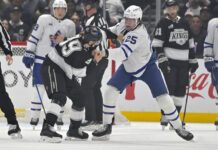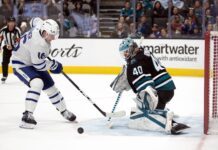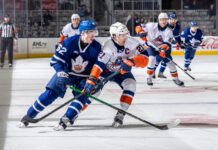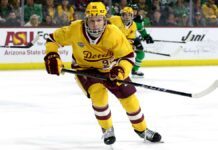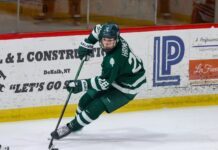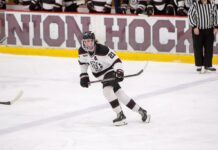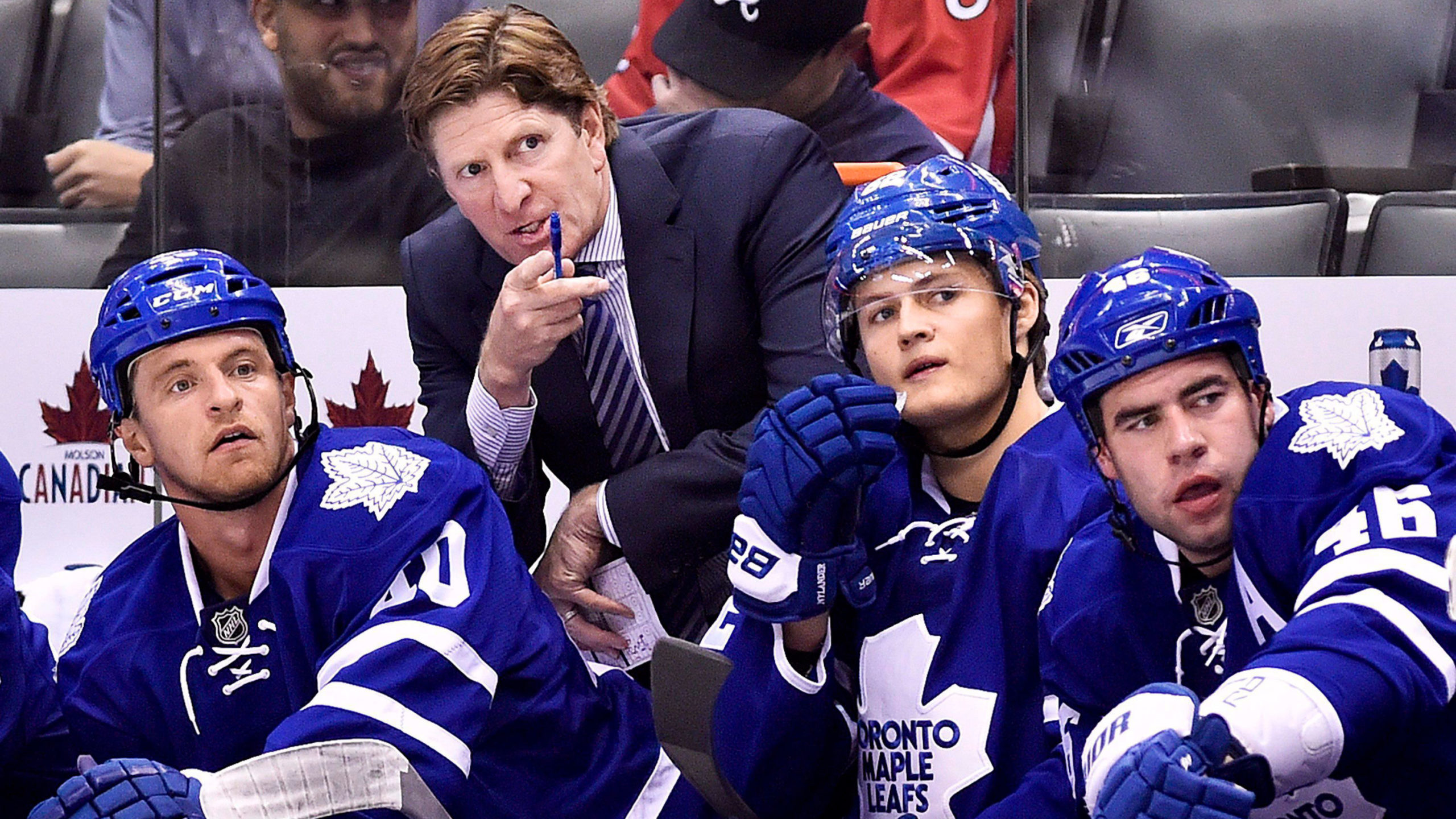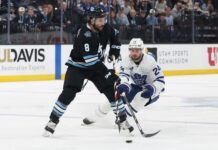All season, I’ve been tracking scoring chances and zone entries for the Toronto Maple Leafs (some details on scoring chances are here; on zone entries here and here).
With the season in the books and last place secured, it’s time to take a look back and sum things up. I rely on my usual usual sources: the soon-to be retired war-on-ice.com and hockeystats.ca, along with Puckalytics and Corsica Hockey, for supporting data.
| Team | CorsiF% | ESCorF% | Chance% | ESCh% | ESClCh% | NZ% | ContEnt% |
|---|---|---|---|---|---|---|---|
| Toronto | 52.5% | 51.3% | 49.5% | 47.6% | 47.4% | 50.3% | 40.2% |
| Opponent | 47.5% | 48.7% | 50.5% | 52.4% | 52.6% | 49.7% | 39.5% |
CorsiF% and ESCorF% are the Corsi numbers. Chance%, ESCh% and ESClCh% are the percent of chances for the Leafs overall, at ES and at ES Close, respectively. NZ% is the percentage of zone entries made by a particular team (not counting clearances where no one is pursuing the puck), and ContEnt% measures the percent of entries that are controlled (passes or carries).
The Leafs made a clear gain in their possession statistics this season, even as they suffered in the standings. This was one of the worst Corsi teams in the league in previous seasons, and they finished this year firmly in the top half of the table. While they were able to improve their chance numbers as well, the improvement was not nearly as steep, which may point to how they struggled to find offensive depth. The Leafs did see a drop-off in Corsi when the game was close relative to their overall ES numbers, but no corresponding drop in chances. That might point to the Leafs carrying possession but mostly being kept to the outside while opponents were defending leads. Still, this difference isn’t huge, so it could be statistical noise.
Toronto also saw a drop off in the chance metric over the second half of the season; at the midway point, they were about a percentage point higher. This came despite an improvement in the Corsi number, which may further point to more ’empty’ possessions. The trade deadline, and the addition of several young players to the Leaf lineup, saw the chance numbers improve somewhat steadily for about a month before tailing off almost to a season low after a terrible last couple of games. Given how much the line-up was chopped and changed in that time, it’s difficult to take away much one way or the other.
As with Corsi, the overall zone entry numbers have improved over the second half of the year, with the Leafs managing to get over 50% in the final reckoning. They also were able to strongly reduce the percentage of controlled entries against in the second half, although that may come down to the same factors that affect their Corsi improvement.
Forwards
Through the first half of the seasons, this Leaf team was a fairly normal group before things went haywire after the trade deadline. Thirty forwards suited up for Toronto on the year, and of those only six managed to pass the 60 games mark. That’s a big table, and a lot to look at all at once, so I ended up splitting it up into those who played at least 30 games, and those who played less. ESCh and ESChCl% are chance percentages at even strength and at ES Close. NZ% is the percentage of times the Leafs entered the opponent zone, rather than the opposite, while a player was on the ice. Pers% represents the percentage of Leafs entries that I have directly attributed to that player. ContEnt and OppContEnt are the Leafs and opponents percentage of zone entries that were under control (passed or carried).
| Name | G | ESCF% | AvESTOI | ZS% | ESCh% | ESChCl% | NZ% | ContEnt | OppContEnt | Pers% |
|---|---|---|---|---|---|---|---|---|---|---|
| van Riemsdyk | 40 | 54.6% | 14:57 | 64% | 55.6% | 58.9% | 47.5% | 47.2% | 41.3% | 34.8% |
| Greening | 30 | 53.8% | 11:56 | 49% | 50.8% | 53.3% | 50.7% | 36.3% | 39.9% | 24.1% |
| Boyes | 60 | 55.1% | 09:33 | 51% | 48.0% | 52.5% | 50.6% | 36.6% | 36.8% | 30.7% |
| Parenteau | 77 | 53.8% | 13:26 | 58% | 51.2% | 51.6% | 49.0% | 41.7% | 40.2% | 26.4% |
| Komarov | 67 | 53.3% | 13:59 | 51% | 49.8% | 49.7% | 50.7% | 46.3% | 39.3% | 25.8% |
| Kadri | 76 | 52.6% | 15:32 | 51% | 48.7% | 49.4% | 51.0% | 48.0% | 40.2% | 31.8% |
| Bozak | 57 | 51.6% | 14:22 | 57% | 50.2% | 48.6% | 48.2% | 43.2% | 41.8% | 21.0% |
| Holland | 65 | 52.0% | 11:48 | 47% | 48.0% | 48.1% | 50.0% | 36.4% | 38.4% | 27.2% |
| Froese | 56 | 48.8% | 09:45 | 32% | 43.2% | 46.1% | 50.6% | 31.9% | 36.8% | 21.0% |
| Matthias | 51 | 50.0% | 11:33 | 55% | 43.0% | 43.1% | 48.1% | 37.6% | 41.5% | 27.9% |
| Grabner | 80 | 49.1% | 11:12 | 40% | 45.5% | 43.1% | 51.6% | 41.0% | 38.1% | 21.8% |
| Lupul | 46 | 46.4% | 12:15 | 46% | 43.6% | 42.9% | 49.2% | 33.0% | 39.9% | 26.5% |
| Winnik | 56 | 49.6% | 12:09 | 41% | 45.9% | 41.3% | 52.0% | 32.1% | 38.9% | 34.2% |
| Spaling | 35 | 45.2% | 12:23 | 36% | 43.5% | 36.6% | 50.4% | 33.0% | 39.8% | 17.8% |
One of the big bright spots for the Leafs may have been forgotten by a lot of people, as James Van Riemsdyk didn’t play a single game in the second half. His first half numbers were clearly the best on the team, and no one managed to get particularly close to him in the second half. In that first half, whichever line van Riemsdyk played on was the Leafs’ best at creating chances; he was effective with both Nazem Kadri and Tyler Bozak. Rather than struggling without Phil Kessel to draw attention from the opposition, he thrived, and a full season from him next year could lead to a solid improvement regardless of other roster changes.
The Leafs secured a long-term deal for Nazem Kadri in the immediate after-math of the season, suggesting that Babcock and the team were happy with him as a building block going forward. He was above average in chances for the team, though not one of the leaders, and managed to help turn Leo Komarov into an All-Star. His chance creation rate was second to only JVR, and he was the best Leaf forward at winning the neutral zone as well as at entering the zone with control. However, his defensive numbers still need some work. He did face tough opposition, and wasn’t protected in zone starts, but he had one of the highest rates of chances against, and did poorly at preventing controlled entries.
Tyler Bozak missed a large chunk of the season with injury, but in a year when many predicted he would flounder without Phil Kessel, he had a solid campaign. He managed to answer some of those critics, but his Corsi number when away from Van Riemsdyk was unimpressive, and overall his offensive contribution was about average.
Leo Komarov‘s all-star season slowed down in the second half, but he was still an effective player, and formed a solid pairing with Kadri. The line of JVR-Kadri-Komarov was one of the most effective units the Leafs used in terms of possession and chances, and I’d be interested to see that reprised next season.
The Komarov-Kadri duo were often given Michael Grabner on the wing, which wasn’t nearly as effective. Overall, Grabner was given more difficult minutes than any other Leaf forward, and while his defensive numbers weren’t bad given that context, he was weak offensively, especially when he was away from Komarov and Kadri.
While Peter Holland didn’t get particularly difficult minutes, and also hasn’t been a consistent point producer, he had his best season since I’ve been tracking him, managing to move up close to average.
It was a miserable season for Joffrey Lupul. He didn’t get much of a chance with the top lines, but he didn’t do much to show he deserved one. His offensive performances were anemic, his possession stats were poor, and he had one of the worst numbers among the forwards for controlled entries. He is still under contract for another two seasons at a cap hit of over $5 million, and is nowhere close to providing that value.
That the Leafs were unable to turn P.A. Parenteau into any asset at the deadline seemed odd. He was a solidly effective player — one of only four forwards to finish above even in chance production. He also improved his numbers substantially in the second half, even without Bozak and JVR playing with him. Perhaps he was kept around because the offers were weak and the organization thought he would work well with their young players. He did manage to put up strong numbers with Zach Hyman and William Nylander.
In contrast, Shawn Matthias, who was one of the weakest defensive forwards, and near the bottom in terms of chance numbers, was shipped out.
Brad Boyes seemed never to gain the confidence of Mike Babcock. Despite having consistently good possession numbers all year, he rarely featured with the top players, with his most common linemate being Byron Froese. Part of why his possession stats look good is down to usage, as he rarely faced top opponents.
Colin Greening had similar results in his thirty games, as he was used against weaker opposition but did manage to turn that into solid chance numbers.
| Name | G | ESCF% | AvESTOI | ZS% | ESCh% | ESChCl% | NZ% | ContEnt | OppContEnt | Pers% |
|---|---|---|---|---|---|---|---|---|---|---|
| Arcobello | 20 | 58.1% | 10:28 | 67% | 52.7% | 57.5% | 48.7% | 38.0% | 33.5% | 22.6% |
| Soshnikov | 11 | 53.4% | 14:03 | 52% | 54.1% | 51.2% | 51.5% | 55.1% | 36.9% | 27.5% |
| S. Carrick | 3 | 32.7% | 09:52 | 83% | 30.8% | 50.0% | 45.2% | 40.5% | 37.3% | 26.2% |
| Leipsic | 6 | 55.6% | 12:12 | 49% | 40.0% | 50.0% | 52.2% | 42.6% | 40.4% | 25.0% |
| Brown | 7 | 53.1% | 11:04 | 61% | 47.1% | 50.0% | 50.9% | 39.1% | 38.7% | 18.2% |
| Smith | 16 | 48.7% | 11:59 | 32% | 44.9% | 47.1% | 52.0% | 32.9% | 40.0% | 24.0% |
| Michalek | 13 | 45.0% | 11:25 | 37% | 45.6% | 47.1% | 49.3% | 35.7% | 34.4% | 28.1% |
| Laich | 21 | 47.2% | 11:27 | 40% | 41.0% | 46.4% | 51.7% | 30.9% | 42.3% | 25.8% |
| Hyman | 16 | 55.8% | 13:47 | 64% | 48.8% | 45.6% | 51.6% | 44.3% | 39.9% | 34.7% |
| Kapanen | 9 | 51.2% | 13:01 | 74% | 46.6% | 44.4% | 48.0% | 43.5% | 38.4% | 23.1% |
| Nylander | 22 | 53.9% | 13:36 | 62% | 46.0% | 44.0% | 51.9% | 43.4% | 39.1% | 26.1% |
| Clune | 19 | 53.8% | 08:17 | 44% | 46.6% | 41.0% | 52.4% | 28.1% | 28.1% | 27.3% |
| Lindberg | 6 | 49.7% | 13:16 | 58% | 48.4% | 33.3% | 52.9% | 36.8% | 37.5% | 30.8% |
| Leivo | 12 | 53.7% | 09:39 | 59% | 34.7% | 27.3% | 51.5% | 29.5% | 27.6% | 27.7% |
| Gauthier | 7 | 40.3% | 10:48 | 40% | 22.5% | 19.0% | 53.7% | 41.0% | 38.6% | 22.2% |
In his 20-game debut, William Nylander showed flashes of potential, and also that he still has a lot to work on. His Corsi numbers were good, but his chance numbers lagged well behind. He was the best of the young forwards at creating chances, but he was well behind the likes of Kadri and Bozak. He did have strong numbers when playing with Parenteau, and had a nice controlled entries percentage.
Zach Hyman, who often lined up beside Nylander, had slightly better numbers than his linemate, and, as mentioned above, formed an effective unit with Nylander and Parenteau.
The best of the young players was Nikita Soshnikov. He benefited from getting a lot of time with established players in Kadri and Komarov, but he performed excellently in that time. His chance numbers are among the best on the team. This is down to some strong defensive numbers, as his run with Kadri and Komarov saw them allow very few chances against. The sample was really small, but he has definitely made himself a name to watch going into next year.
Mark Arcobello isn’t a young player anymore, but his 20 Leaf games made a case that he may still be an effective NHL player. While he did get very easy zone starts, his possession and chance numbers were excellent, and he could be an useful player in a small role at the bottom of the lineup.
Most of the other young players are hard to assess in limited ice-time. Frederik Gauthier‘s numbers look terrible, but he did get much tougher zone starts than most of the other young players. Brendan Leipsic and Josh Leivo can have similar complaints; their numbers look bad, but the context is tough.
Defence
A 30-game cut-off limits this table to seven men, but I’ll have some brief thoughts on the others at the end.
| Name | G | ESCF% | AvESTOI | ZS% | ESCh% | ESChCl% | NZ% | ContEnt | OppContEnt | Pers% |
|---|---|---|---|---|---|---|---|---|---|---|
| Polak | 55 | 49.9% | 16:15 | 48% | 48.50% | 52.30% | 47.30% | 37.60% | 37.00% | 10.60% |
| Corrado | 39 | 55.0% | 13:15 | 58% | 47.70% | 50.70% | 58.10% | 41.00% | 37.40% | 10.70% |
| Gardiner | 79 | 53.3% | 17:57 | 51% | 48.30% | 49.40% | 51.60% | 41.80% | 39.00% | 13.90% |
| Phaneuf | 51 | 51.3% | 17:22 | 52% | 47.60% | 49.40% | 52.40% | 41.40% | 40.40% | 10.50% |
| Marincin | 65 | 53.6% | 14:17 | 54% | 47.60% | 48.50% | 53.90% | 37.30% | 36.20% | 10.60% |
| Rielly | 82 | 50.0% | 18:57 | 47% | 47.90% | 44.00% | 47.00% | 41.30% | 41.30% | 18.50% |
| Hunwick | 60 | 47.3% | 18:39 | 44% | 43.20% | 41.00% | 42.50% | 39.70% | 42.20% | 11.90% |
Morgan Rielly has fairly poor numbers compared to the rest of the defence, but he had a reasonable season this year, and the Leafs seem to have done a decent piece of business in locking him up. While his overall numbers aren’t spectacular, lagging behind in Corsi and in chances, especially at ES Close, it all comes down to context. Rielly faced tougher competition and had harder zone starts than everyone else other than Matt Hunwick, and Hunwick was well below Rielly in every metric. In addition to producing strong offensive chance numbers, Rielly also was the best defenceman at winning the neutral zone, and was far more likely than the rest of the defence to be the player driving zone entries. 18% of Leafs entries were by Rielly when he was on, no one else on the defence got above 14%. His numbers saw some uptick in the second half, and that may be due to context as well. His minutes were somewhat easier, as Babcock didn’t bury him quite as much, but he also benefited from replacing Matt Hunwick with Martin Marincin as his partner.
Jake Gardiner had a relatively strong season, and a major improvement over last year. In the first half, that was heavily down to context, as he and Dion Phaneuf faced relatively easy minutes. Once Phaneuf was gone, Gardiner started to see tougher ice-time. That didn’t really affect his chance and possession numbers, which stayed about the same, and he ended up well ahead of Phaneuf in both metrics. His pairing with Frank Corrado worked well, although Corrado ended up behind him in the table despite playing easier minutes in the early parts of the season. Corrado also had excellent numbers in the neutral zone, as the Leafs had 58% of entries while he was on the ice.
Martin Marincin is the reverse of Rielly; his numbers got substantially worse over the second half, as his matchups against bottom pairings and fourth lines mostly disappeared. His chance numbers were relatively poor despite those easy minutes, but his Corsi numbers were strong, among the best of the blue-line. A lot of that comes down to a lack of generated offense on the bottom pairing, which is reflected in his controlled entries number — the worst of any regular defenceman.
Roman Polak finished as the best defenceman in terms of chances before being shipped to San Jose, a major contrast from last season, when he was near the bottom. As with the other defencemen, this was mostly down to context, as he went from having the toughest minutes on the team last year to mostly avoiding opponents’ top players under Babcock. That was a job well done by Babcock to get Polak playing well in a good spot so he could be moved for value.
T.J. Brennan and Andrew Campbell had poor stints with the big club. Brennan in particular didn’t impress, as in soft minutes he was one of the worst Leaf players in terms of chances.
Connor Carrick fared much better in his audition — over 50% in chances in 16 games — and should be a name to watch coming into next season.
Rinat Valiev managed decent numbers in limited time, while Scott Harrington, who started the season with the club, had good numbers in soft minutes for the first month or so.
Wrapping Up
Altogether, there is a lot of promise in the improvement of possession statistics, and some good individual performances. To turn that into an improvement in the standings, the Leafs will need continued development from young players, including the injection of more offensive talent. It will be fascinating to follow what the front office does to alleviate that concern over the summer.





